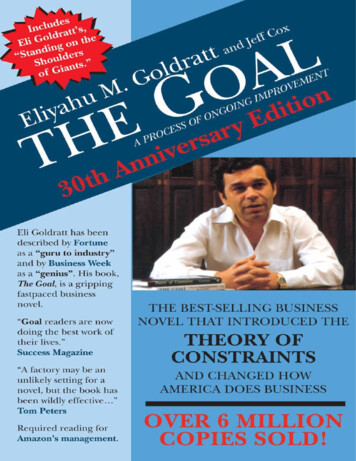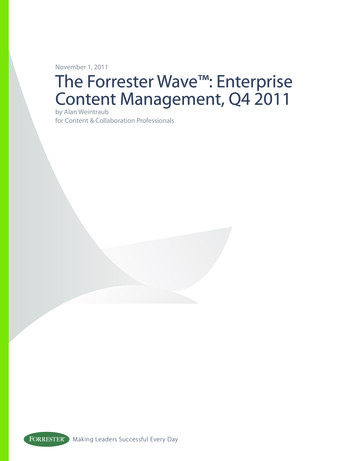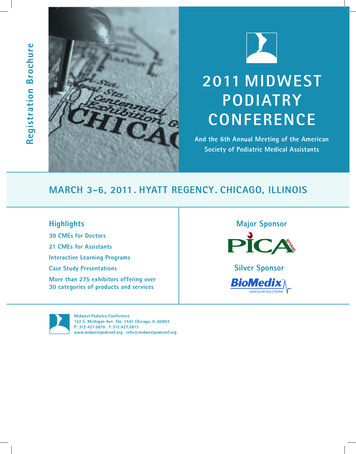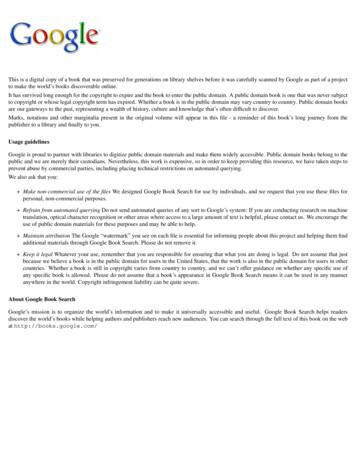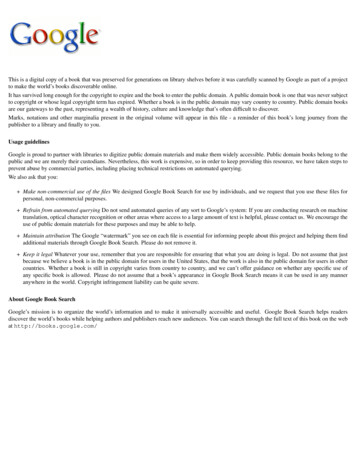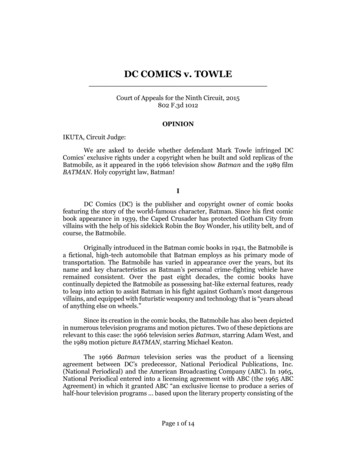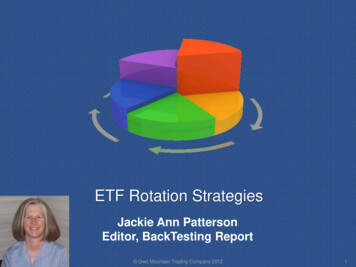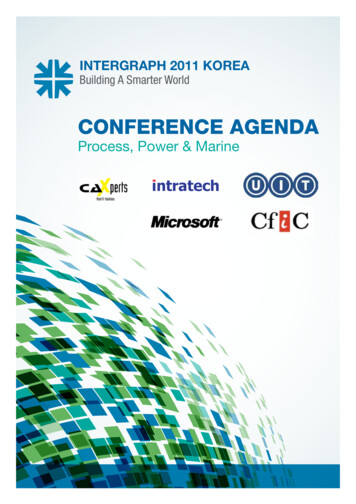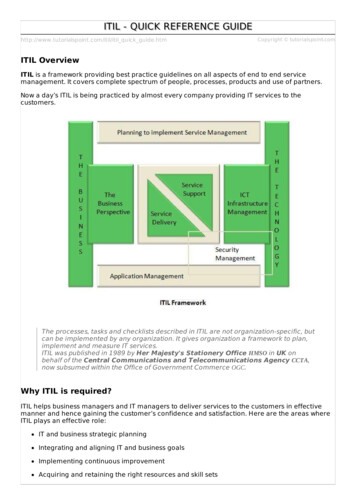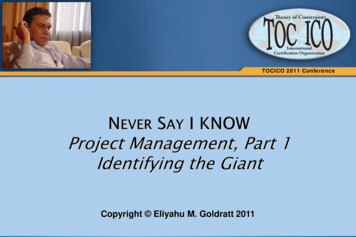
Transcription
TOCICO 2011 ConferenceCopyright Eliyahu M. Goldratt 2011
THE world experts inproject management.
Dr. Goldratt, we knoweverything there is to knowabout PM. Nevertheless, todetermine how long a projectwill take, our standard practiceis “multiply x 4 and pray.”Our problem is that OURPRAYERS ARE NOT ACCEPTED.We read THE GOAL. It is notthe solution for our projectmanagement environment, butwe are convinced if anybodycan figure it out, it’s probablyyou.
I am an expert in production,not project management!Here, take these 2 booklets –they contain everything we knowabout project management.
The key for projects was thelead timeThe lead time was determinedby the critical pathIn a typical project of 40,000tasks, the critical path was only40 tasks!
Eli found company in his quest for FOCUSIn a different fieldOn a much more massive scaleProductionDon’t look on 100types of resources,look on only 1 – thebottleneck!Focus on 1%ProjectsDon’t look on 40,000tasks, look on only40 – the critical path!Focus on 0.1%
I’ve been thinking too narrowly! Statoilis giving me exactly the samematerial, only more profound.Whether in projects or production, it’sCONSTRAINTS we’re dealing with!In Production Constraint is capacity-basedIt’s the BottleneckIn Projects Constraint is time-basedIt’s the Critical Path2 weeks later,everything waschanged from OPTto Theory ofConstraints. and Eli was off to Oslo
By the timereachedWhenhea taskon theOslo,Eli hadcriticalpaththetakes lessanswer.timethan its estimate,Whena taskthe projectshouldtakeon theshorter. criticalBut thatpathis takesTheactualdurationoflongeritsapparentlynot !Thedurationof tly– sumfromThereismustbe a ofthedurationof lTheseare notstupidassumptionispath.people– andStatoilmissed,whichis inparticularis thedevouringthebesttime.in theworld atprojects! TheirThink estimates must be, onaverage, good enough –how could it be thatCritical Pathmultiplying x such a largeprovides projectfactor still does notcompanies with aprovide enough time?fantastic ability tofocus. Nevertheless,5 latehourstothey areevenOslo.Whatwhen they“multiplyam I goingx 4 andpray”!to tellthem?
There are dependenciesand variablesAggregation of UncertaintyShow me how you measure me, I’llshow you how I’ll behave.Task timeestimate task timecommitment,explains whyonly delaysaccumulateSolutionAggregate the safety inproject and feedingbuffers (eliminate thesafety per task)Task time estimate task time commitment
Process1.2.3.4.5.6.The giantEnormity of unaffected areaGetting on the giant’sshouldersConceptual differenceWrong assumptionFull analysisOn the Shoulders of CriticalPath1.2.3.4.5.6.Critical PathAll projectsCritical Path defines the projectduration and provides the ability tofocus on the few elements that makethe real difference in the project’s leadtime.The time estimate for each task istaken as a commitment, leading toelongated estimates, and the inabilityto gain time when tasks less time thanestimated.Shorter than estimated tasks result inshorter project durationCritical Chain project planning
TOCICO 2011 ConferenceWhere is bad multitasking?For this, we must wait 5years, to 1991
Saddam Hussein launches missiles on Israel duringGulf WarIsrael, our dear friends,please don’t retaliate.Take these F-16sinstead They just needa little bit of work The backbone of the Israeli AirForce Israel is a small country withlimited budget Limited budget meant limitedmaintenance resources
50Super EngineerOn average, 14 months fromfirst file opened til last file closedSuper EngineerSuper EngineerPlanearrivesBy ect, Finalize,Close FileFlightready
50
3Was it written on the tabletsat Mount Sinai that themoment a file is opened itmust be assigned & workedon? The head of base realized this was the key andimmediately implemented the following:We will allow only 3 open files per SuperEngineer, assigning a new one only when 1 of the3 is finished.Duration from opening the first file to closing thelast file went from 14 months to 7 weeks.Overtime was nearly eliminated, no moreengineers were added to accomplish it.
Statoil Israel Air ForceStop planning as if what isuncertain is known.Aggregate the uncertainty!1997 Stop bad multitasking Freeze! Focus - one task at a time.
Combining the two elements of Aggregationand Freeze during CCPM software developmentled to the 3 colors priority managementsystemElbit Systems implementing CCPM in theirmulti-project environment led to inventing the“virtual drum” Which led to non-publication of Project Managementthe TOC Way Projects S&T introduced 2008, verbalizing thefull logic of CCPM and its implementation
Harmony reader available for free download atwww.goldrattresearchlabs.com
Inside Each S&T StepNecessaryAssumption(NA)Strategy (S)What for?ParallelAssumptions(PA)Tactic (T)How?SufficiencyAssumption(SA)The “Why” of the Step. The reason that the higher level S&T step cannot beimplemented unless a change is made. In other words, it describes thenecessity for an action to be taken. (NA is not in highest level of the S&T)Why is what I’m responsible for really needed by the organization toimprove vis-à-vis its goal?The “What” of the Step. The objective – the intended outcome – of the S&Tstep. When the strategy is achieved, the need highlighted by the necessaryassumption is met. What am I/are we responsible for accomplishing?The “Why” of the Tactic. The conditions which exist in reality leading us toa specific course of action that would achieve the strategy; forms the logicalconnection between the tactic and the strategy, explaining why the tactic isthe course of action that leads to the attainment of the strategy. Why willthe action/activity (tactic) achieve the strategy?The “How” of the Step. What needs to be done in order to achieve thestrategy. In a well written S&T step, the tactic is obvious once the parallelassumptions are read. What must I/we do to accomplish the strategy?The “Why” of the next level. Explains the need to provide another level ofdetail to the step. If we don’t pay attention to it, the likelihood of taking theright actions is significantly diminished. (SA is not in lowest level of the S&T)Why is accomplishing this at risk without providing anotherlevel of detail for my subordinates?
Step 1Level 1Strategy(Effect)Parallel AssumptionsTactic(Cause)Sufficiency AssumptionEStep 2.1Step 2.2Necessary AssumptionLevel 2Strategy(Effect)Level 3 of2.13.1.1NAPAT(SA)Strategy(Effect)Parallel AssumptionsParallel AssumptionsTactic(Cause)ECNecessary AssumptionSufficiency )ESufficiency AssumptionCLevel 3 of2.2C3.2.1NAPAT(SA)3.2.2NAPAT(SA)3.2.3NAPAT(SA)
Aggregation of UncertaintyBad MultitaskingStudy the key concepts of theCCPM Solution in the Projects S&T Notice how they are verbalized Notice where they are located3 Colors Priority SystemVirtual Drum
Dr. Goldratt, we know everything there is to know about PM. Nevertheless, to determine how long a project wil

